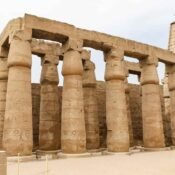
Valley of the Kings
Valley of the Kings is one of the most famous archaeological sites in Egypt, you can have a Hot air balloon Luxor to enjoy sightseeing. it’s the home to the tombs of many famous pharaohs, it’s a great place to visit, learn about ancient history, and appreciate some truly amazing architecture from thousands of years ago. In this blog post, we’ll take a look at why the Valley of the Kings is so special.
The Valley of the Kings
Valley of the Kings (Arabic: وادي الملوك Wādī al-Mulūk; Coptic: ϫⲏⲙⲉ, romanized: džēme Late Coptic: [ˈʃɪ.mæ]), also known as the Valley of the Gates of the Kings (Arabic: وادي أبوا الملوك Wādī Abwāb al-Mulūk), is a valley in Egypt where, for a period of nearly 500 years from the 16th to 11th century BC, rock-cut tombs were excavated for the pharaohs and powerful nobles of the New Kingdom (the Eighteenth to the Twentieth Dynasties of Ancient Egypt).
The valley stands on the west bank of the Nile opposite Thebes (modern Luxor), within the heart of the Theban Necropolis. The wadi consists of two valleys: the East Valley (where the majority of the royal tombs are situated) and the West Valley (Valley of the Monkeys).
With the 2005 discovery of a new chamber and the 2008 discovery of two further tomb entrances, the valley is known to contain 63 tombs and chambers (ranging in size from KV54, a simple pit, to KV5, a complex tomb with over 120 chambers). It was the principal burial place of the major royal figures of the Egyptian New Kingdom, as well as a number of privileged nobles. The royal tombs are decorated with scenes from Egyptian mythology and give clues as to the beliefs and funerary practices of the period. Almost all of the tombs seem to have been opened and robbed in antiquity, but they still give an idea of the opulence and power of the pharaohs.
This area has been a focus of archaeological and Egyptological exploration since the end of the eighteenth century, and its tombs and burials continue to stimulate research and interest. Since the 1920s, the valley has been famous for the discovery of the tomb of Tutankhamun, and is one of the most famous archaeological sites in the world. In 1979, it became a World Heritage Site, along with the rest of the Theban Necropolis. Exploration, excavation and conservation continues in the valley, and a new tourist center has recently been opened.
Exploration the valley
valley of the Kings has been a major focus of modern Egyptological exploration for the last two centuries. Prior to this time, it was a site for tourism in antiquity (especially during Roman times). The area illustrates the changes in the study of ancient Egypt, starting as antiquity hunting, and ending as scientific excavation of the whole Theban Necropolis. Despite the exploration and investigation noted below, only eleven of the tombs have actually been completely recorded. (you can have an see all of the valley during your hot air balloon flight in Luxor)
Many of the tombs have graffiti written by those ancient tourists. Jules Baillet has located over 2,100 Greek and Latin instances of graffiti, along with a smaller number in Phoenician, Cypriot, Lycian, Coptic, and other languages. The majority of the ancient graffiti is found in KV9, which contains just under a thousand of them. The earliest positively dated graffiti dates to 278 B.C.
In 1799, members of Napoleon’s expedition to Egypt (especially Vivant Denon) drew maps and plans of the known tombs, and for the first time noted the Western Valley (where Prosper Jollois and Édouard de Villiers du Terrage located the tomb of Amenhotep III, WV22). The Description de l’Égypte contains two volumes (out of a total of 24) on the area around Thebes.
Tourism in kings valley
Most of the tombs are not open to the public (18 of the tombs can be opened, but they are rarely open at the same time), and officials occasionally close those that are open for restoration work. The number of visitors to KV62 has led to a separate charge for entry into the tomb.
The West Valley has only one open tomb—that of Ay—and a separate ticket is needed to visit this tomb.[56][108] The tour guides are no longer allowed to lecture inside the tombs, and visitors are expected to proceed quietly and in single file through the tombs. This is to minimize time in the tombs and prevent the crowds from damaging the surfaces of the decoration.
In 1997, 58 tourists and four Egyptians were massacred at nearby Deir el-Bahari by Islamist militants from Al-Gama’a al-Islamiyya. This led to an overall drop in tourism in the area.
On most days of the week an average of 4,000 to 5,000 tourists visit the main valley. The West Valley is much less visited, as there is only one tomb that is open to the public.
Recent Posts
Luxor day tour: Most Illuminated Temples
Discover Luxury Nile Cruises
Designing the Perfect Itinerary for Your Nile Cruise




